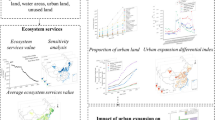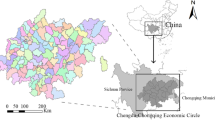Abstract
Mineral resources exploitation significantly affects the spatial structure and evolutive trend of urbanization in arid areas. In this study, the spatial autocorrelation method and the spatial computation model were used to investigate the spatial impacts of mineral resources excavation and processing on comprehensive level of urbanization in the Tarim River Basin, Xinjiang, China for the years of 2000, 2006 and 2008. The results are as follows: 1) There was a spatial correlation of the development of mineral resources industry and the comprehensive level of urbanization in 2006 and 2008, with the spatial concentration trend rising significantly in 2006 and decreasing in 2008. 2) The patterns of local spatial concentration of mineral resources industry and of the comprehensive level of urbanization were relatively stable, and the two patterns showed signs of spatial correlationship. The higher was the degree of the concentration of mineral resources industry, the stronger was its impact on the spatial clustering of urbanization. 3) In 2000, mineral resources excavation and processing had a significant positive impact on the comprehensive level of urbanization in the region but not in its adjacent regions. However, in 2008, mineral resources excavation and processing significantly raised the comprehensive level of urbanization not only in the region but also in its neighboring regions. This research demonstrates that the development of mineral resources industry can strongly affect the trends and spatial patterns of urbanization.
Similar content being viewed by others
References
Anselin, L, 1995. Local Indicators of Spatial Association—LISA. Geographical Analysis, 27(2): 93–115.
Anselin L, Florax R J G M, Roy S J et al., 2004. Advances in Spatial Econometrics: Methodology, Tools and Applications. Berlin: Springer-Verlag.
Chen Mingxing, Lu Dadao, Zha Liangsong, 2010. A comprehensive evaluation of China’s urbanization and the effects on resources and environment. Journal of Geographical Sciences, 20(1): 17–30.
China Statistical Bureau, 2001; 2009. China Statistic Yearbook (2001; 2009). Beijing: China Statistical Press. (in Chinese)
China Statistical Bureau, 2001; 2007; 2009. Aksu Prefecture, Kashgar Prefecture, Hotan Prefecture, Kizilsu Kirgiz Autonomous Prefecture, Bayingolin Mongol Autonomous Prefecture Statistic Yearbook (2001; 2007; 2009). Beijing: China Statistical Press. (in Chinese)
China Statistical Bureau, 2005. Statistical Yearbook on 50 Years of Xinjiang. Beijing: China Statistical Press (in Chinese).
Cliff A, Ord JK, 1981. Spatial Processes: Models and Applications. Pion, London.
De F D, Perry G, Lederman D, Maloney W, 2002. From Natural Resources to the Knowledge Economy. Washington, DC: The World Bank.
Dong Wen, Du Hongru, Zhou Yanshi, 2010. A Study on Resource-based industry and urban development in the the Urumqi-Changji region, China. Journal of Natural Resources, 25(4): 657–667. (in Chinese)
Jin Donghai, Qin Wenli, 2004. On natural resources base for urbanization. Human Geography, 29(4): 64–67. (in Chinese)
Jing puqiu, Zhang Fuming, 2005. Inconformity and conformity of industrialization and urbanization in resource-based regions. Human Geography, 86(6): 38–41. (in Chinese)
He Canfei, Zhu Yangang, 2010. An empirical study on the geographical distribution of resource-based industries in China—A case study of oil processing and coking industry and ferrous metal smelting androlling processing industry. Jounal of Natural Resources, 25(3): 448–501. (in Chinese)
Li Chunhua, Zhang Xiaolei, Wang We, 2003. Comment on the process of urbanization in Xinjiang. Arid Land Geography, (4): 396–401. (in Chinese)
Li Rong, 2009. Analysis of Industry Concentration in Promoting the Urbanization. Chongqing: Chongqing Technology and Business University. (in Chinese)
Li Shaoxing, 2009. ’The curse of natural resources’ in the process of urbanization and its mechanism. Ecological Economy, (5): 136–138. (in Chinese)
Li Xuemei, 2010. The Function Mechanism and Special Effect of Mineral Resources Exploitation on Urbanization—A Case Study in the Tarim River Basin. Urumqi: Xinjiang Institute of Ecology and Geography Chinese Academy of Sciences. (in Chinese)
Li Xuemei, Zhang Xiaolei, Du Hongru et al., 2010. Resource exploit on the region development: Take xinjiang as example. Journal of Natural Resources, 25(11): 1823–1833. (in Chinese)
Liu Xifeng, Li Chengu, Tan Xuelan, 2002. Analysis on the features and mechanism of urbanization in northeast China. Urban Problems, 109(5): 17–23. (in Chinese)
Miao Jianxing, Du Pinglong, 1994, The ore-controlling structures, ore-forming series and ore-searching prediction in Talimu plate and its adjacent areas. Volcanology and Mineral Resources, 15(02): 53–68. (in Chinese)
Qiao Xuning, Yang Degang, Zhang Xinhua, 2009. Evolvement stages of oasis economy and its dependence on natural resources in the Tarim River Basin. Chinese Geographical Science, 19(2): 135–143. doi: l0.1007//s11769-009-013-8
Shen L, Cheng S, Aaron J G et al., 2005. Urbanization, sustainability and the utilization of energy and mineral resources in China. Cities, 22(4): 287–302. doi: 10.1016/j.cities.2005.05.007
Shi Yulin, 2006. Resources Science. Beijing: High Education Press. (in Chinese)
Wang Ping, 2009. A Study on Mineral Exploit and Industrializationin Xinjiang. Lanzhou: Northwest University for Nationalities. (in Chinese)
Wang Shijun, 2007. The Research on Economic Development Strategy of Mineral Resources Industry in Hebei Province. Beijing: China University of Geosciences. (in Chinese)
Wu Zhongguan, Liu Jiaqiang, 1996. The Panzhihua mode: Study on the mode of population urbanization. Tianfu New Theory, (5): 12–18. (in Chinese)
Xu Xueqiang, Zhou Yixing, Ning Yueming, 1997. Urban Geography. Beijing: Higher Education Press. (in Chinese)
Yu Ruixiang, Hong Shuifeng, 2001. Status of mineral resources in the western development strategy. Journal of China University of Geosciences, 26(6): 661–664. (in Chinese)
Zhang Lei, 2009. The Resource-environment Base for China’s Urbanization. Beijing: Science Press. (in Chinese)
Zhang Huixing, 2009. Dynamic Mechanism of Resource-based Industrial Cluster in China. Xian: Northwest University. (in Chinese)
Zhang Xiaolei, 2002. Influence of desert mineral resource exploitation on the spatial structure of the urban system in Xinjiang. Science in China, 45(s1): 180–184.
Zhang Xiaolei, Lei Jun, 2006. Trends of urban system structure under the restriction of water and land resources in Xinjiang. Chinese Science Bulletin, 51(s1): 148–155. doi: 10.1007/S11434-006-8224-x
Author information
Authors and Affiliations
Corresponding author
Additional information
Foundation item: Under the auspices of Chinese Academy of Sciences Western Doctor Special Financial Aid (No. XBBS200812), National Natural Science Foundation of China (No. 40601032)
Rights and permissions
About this article
Cite this article
Li, X., Zhang, X., Du, H. et al. Spatial effect of mineral resources exploitation on urbanization: A case study of Tarim River Basin, Xinjiang, China. Chin. Geogr. Sci. 22, 590–601 (2012). https://doi.org/10.1007/s11769-012-0554-9
Received:
Accepted:
Published:
Issue Date:
DOI: https://doi.org/10.1007/s11769-012-0554-9




